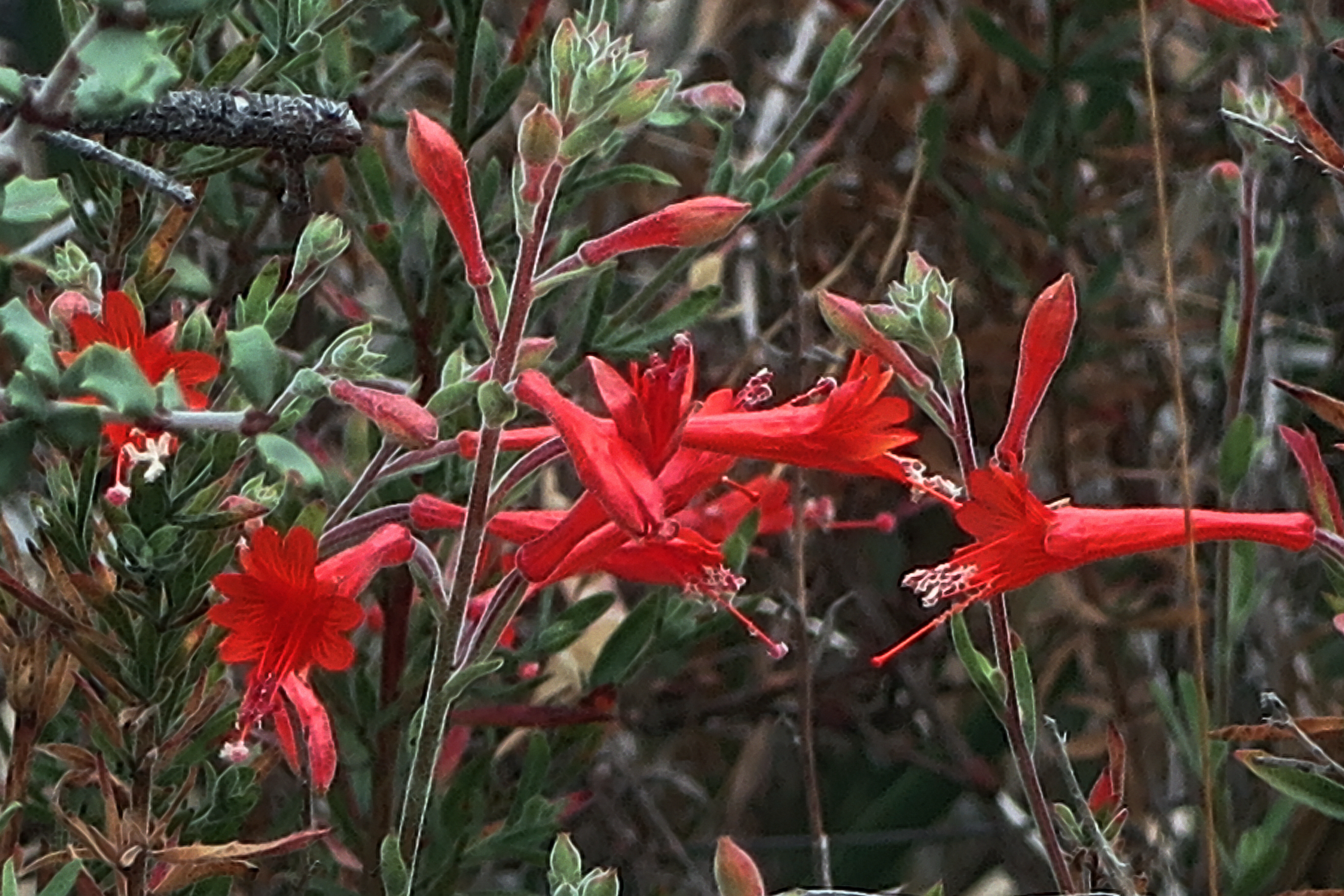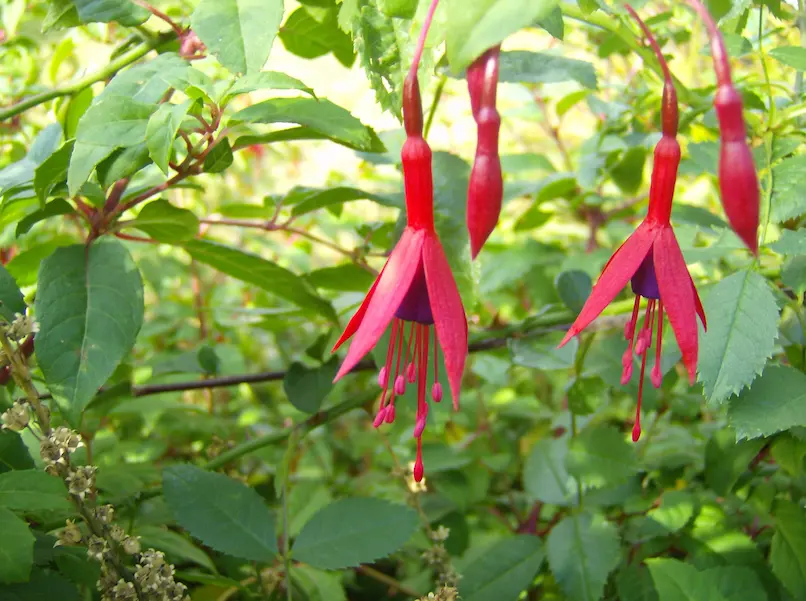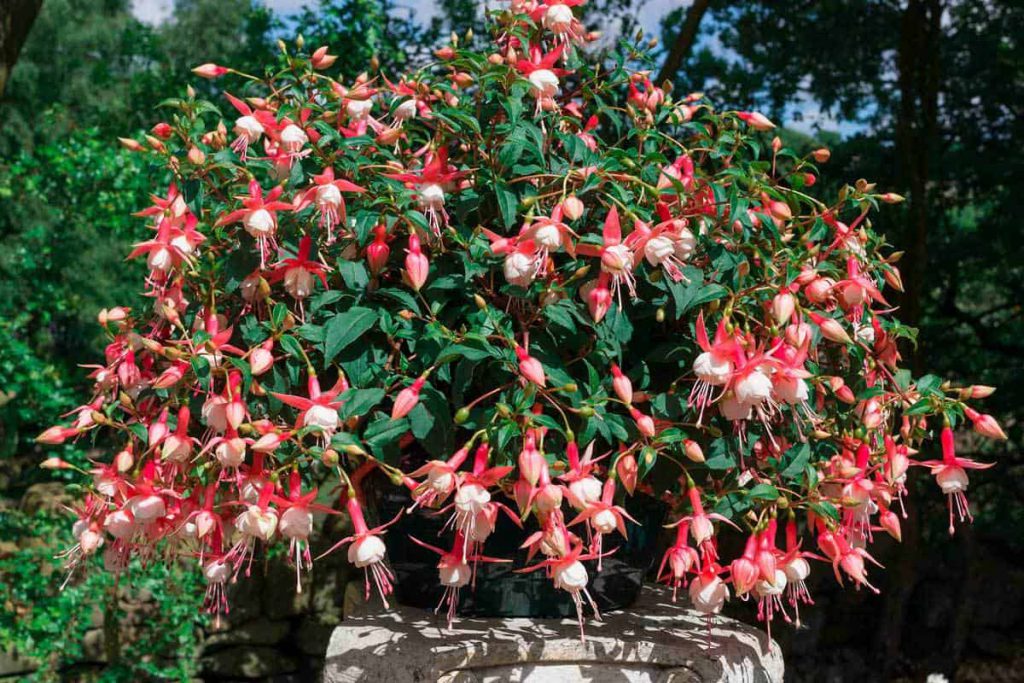Your cart is currently empty!
Grey Headed Coneflower
Grey headed Coneflower has eye-catching yellow flowers that entice birds and pollinators. It is ideal for natural plantings and meadows.
Your cart is currently empty!
The Fuchsia plant is an easy care plant. Fuchsia can also be trimmed and fashioned into bushy plants to form lovely arrangements and hanging baskets. Because of their vibrant colours, they are also appealing indoors. They also make great patio blooming plants in pots.
Fuchsia “Chillerton Beauty” is a hardy upright free-flowering Fuchsia native to Oregon and Washington. This tropical and sensitive perennial is hardy in USDA zones 8-11.

Honeysuckle fuchsia also grows in USDA Hardiness zones 9-11. This species requires protection for long spells of temperature under 32° degrees Fahrenheit.
Zauschneria, or California fuchsia, is another evergreen shrub under the Onagraceae family. It loves well-drained soils in full sun and attracts a large number of hummingbirds. The funnel-shaped crimson blooms emerge in late summer and early autumn.

There are a few dozen types of fuchsia. We recommend this page on the site Wikihow.
There are numerous types of fuchsia flowers and many colorings. There are:
Each fuchsia type is beautiful and they all have their own special merits. You will find the singles bloom much more abundantly. Fuchsias come in almost every color with new flower color combos being released every season.
Fuchsias need coolness above all else. They prefer that temperatures never go over 65° degrees Fahrenheit but they can stand higher ones providing the humidity is high, too. I once had a plant that inadvertently got set outdoors in early spring and was forgotten until it burst into full bloom.
As an experiment, I left it where it was all summer, and despite almost full sunlight and hot days, it did remarkably well. Mostly, I think, because the nights were cool and dewy, and during the daytime, I showered it with the hose every time I got near it.
Fuchsia magellanica is one of the progenitors of today’s fuchsias. It is a hardiness zone 6 – 11 plant. Some are being grown in zone 5. Other fuchsias were discovered years later in South America, off the coasts of South America, and in Mexico. These hardy Fuchsia types all produced very few blooms that were really lovely. The original fuchsia plant has undergone numerous modifications throughout the years, and it is doubtful that the ancestors of today’s lovely fuchsia would recognize their progeny.

Fuchsias are thirsty plants. They should always be kept wet with daily watering. They want a lot of water, but make sure there is adequate drainage.
These are plants that like moist conditions, which may be produced by misting the leaves with a fine mist of water. The plant should be sprayed at least twice a week. During the hot summer months, a daily spray will be quite useful. The heat drains moisture from your plants’ leaves, which fuchsias will not tolerate. By spraying, you may increase humidity, keep your plants in good developing condition, and ensure a constant abundance of blooms.
If you notice any insects on your plant when spraying, you can use a forcible spray to jar loose any insects that might be trying to get a foothold.
When you water with a spray, the root ball is not fully hydrated. When watering, make sure to moisten the soil. It is preferable to water less frequently and thoroughly than to skim over them once in a while. Water must penetrate the soil surface in order for all of the roots to be hydrated.
Fuchsias can attract whitefly, fuchsia gall mites, and red spider mites. Slugs are also feeding on the new growth. Aphids like to feed on fuchsias. Get rid of these insect pests with the methods described here.
You can prune your fuchsias into beautiful hanging baskets.
In the fall or early spring, prune your fuchsias. Upright growers are best cut back to about 8 or 10 inches from the ground. This gives you the main stem of new, healthy wood and keeps your plant in bounds. Your new wood is the flowering wood, and you will have more flowers by pruning in this way.
Fuchsias prefer shade, but there are several types that will thrive in the sun. Your orange and red varieties will fare better in the sun than your pastels or double kinds. They do considerably better in semi-shade or early morning light. Sun-grown plants require regular monitoring and frequent watering, particularly spraying.
However, it is best to keep the plants out of direct sunlight.
Growing fuchsias is very easy as they can grow so quickly and they start to bloom when young. They are also good specimens for a garden because of their beautiful leaves and flowers. Like other plants in the genus Fuchsia, they require pruning in order to keep them within bounds, or else they’ll take over the whole garden! The long stems terminate into four reflexed lobes that expose flower petals – usually five or more per stem, but sometimes just one at each end – in shades from white through pink to deep red.
Never overpot small plants when starting them. Continue to use the next-largest pot as required. This method will allow your plants to develop faster and have a much healthier root system. Remember to pinch your young plants, feed them carefully, water them well, give their leaves a wash, and treat them with a strong pesticide if you want to develop great fuchsias.
When you start, small plants should not be overpotted. Keep shifting to the next larger pot as needed. Your plants will grow faster and have a much better root system if grown this way. Remember to pinch your young plants, feed them well, water them well, give their foliage a bath and spray with a good insecticide, and you can grow fuchsias that are outstanding.
When your fuchsia has grown to be a healthy bushy plant in a four or five-inch pot, it is ready to be placed in a hanging basket.
When potting Fuchsias:
Feeding will result in a plant that is brimming with lovely blossoms.

Planting basket fuchsias in a wire hanging basket is a lovely technique to cultivate them. Line your basket with sphagnum moss, then fill it with potting soil and plant your fuchsia. Hang your basket and work the roots of Baby Tears Moss into the sphagnum moss and beneath the wires. The baby tears will quickly take hold and spread throughout your basket, resulting in a lovely green basket.
In the winter, place your fuchsia in a very cold but frost-free spot.
When the plants finally become established in the pot size you want them to flower in, use a liquid plant food in place of every third watering, fuchsias are heavy feeders, and soon spindle out unattractively unless kept well fed.
Plants may also start from seed in January or February.
From cuttings, cut newer growth. The best cuttings are from suckers which spring up from the base of the plants. They should be about three to five inches long, with leaves removed from the lower 2 or 3 inches of the cutting.
Option 1: Plant the seeds or cuttings in a potting mix. Add extra sand to the potting mix for drainage purposes. Give them shade, a temperature of no less than 60 degrees, keep the soil moist, and softly spritz them if they show indications of withering. Handle them as you would newly acquired tiny plants after they are properly rooted.
Option 2: Add rooting hormone the stems, although fuchsias often root well without it. Because fuchsia cuttings wilt fast if not immediately rooted, store them in a tight plastic bag or soak the ends in a glass of water until ready to use.
If you give your plants plenty of root space in rich, gritty soil, feed and water them freely, and keep them as cool as possible, your fuchsias will live for years and years, expanding in beauty and size all the time. You’ll want more and more of them as you discover how to raise them properly.
Grey headed Coneflower has eye-catching yellow flowers that entice birds and pollinators. It is ideal for natural plantings and meadows.
Find the perfect trellis plants to add color and beauty to your garden. Explore a variety of options and get creative with different trellis designs. Learn more now!
A soil calculator is essential for raised beds and container gardening, which provide easy control of loose, fertile soil. Read on for more.
Learn about winter sowing, a seed-starting method that mimics nature's cold stratification cycle, for successful germination and healthy plant growth.
Growing Bell peppers is a great crop for getting started in gardening. With a short crop cycle and easy care, you can achieve great results.
Discover why mushrooms in your garden can be beneficial, the different types of mushrooms, and whether you should remove them.
GardeningCalendar.ca gets some funding from advertisers. If you click on links and advertisements at no cost to you, the site may receive a small commission that helps fund its operation.
© 2025 J&S Calendars Ltd.
Leave a Reply
You must be logged in to post a comment.